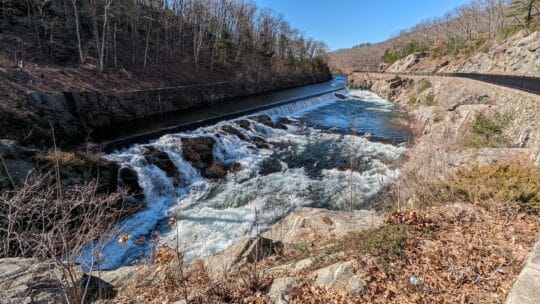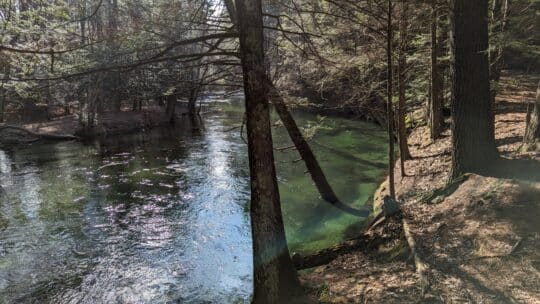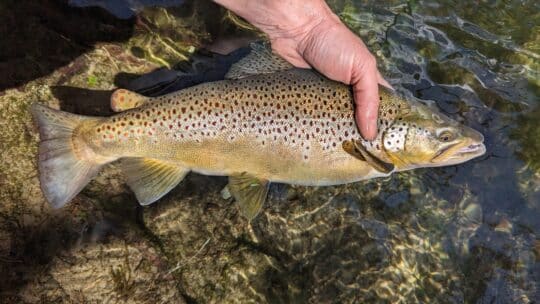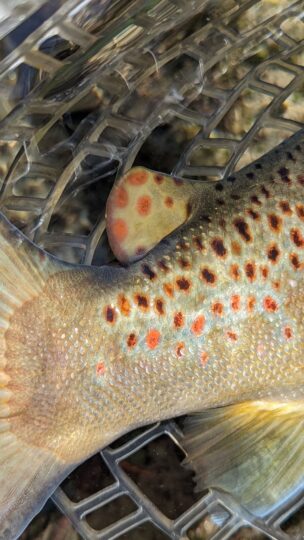With all of the rain this winter and spring, the Quabbin Reservoir has been spilling since January. I have not been fishing the Swift River, but the flows have made for good sightseeing at the spillway. I’ve taken a few walks along the river and learned where the trees have been removed (or deposited). When the water does recede both the trout and the anglers will need to explore new habitats.

It’s been pretty much that way with other MA rivers this spring as well: sightseeing and cross country skiing outings have displaced normal spring fishing outings. Doane’s Falls in Royalston put on a show for us on a weekend hike. We cross-country-skied to Lake Wampanoag where it spills into the Whitman River on April 5th.

Scenery and waterfalls are nice and all, but I had enough this weekend. I grabbed a rod and took a walk along the Swift to explore. From my recent scouting I knew of a spot that seemed to be holding fish. Not wanting to drown, I eschewed waders and went with crocs and shorts to ensure that I would stay out of the water. I was thinking it would be another of my walks, looking at the river and enjoying being outside; I would end up glad I brought along a rod.
If there is one thing I am accustomed to at the Swift River, it is spotting fish. The high flows have made even that difficult, as you have to peer through six or seven feet of crystal clear water and stare at one spot to try to find a fish. Once I spied a rainbow that had staked out a feeding lie, my fishing juices began to flow and I set up on the bank to try to get a drift down to the fish.
My first several casts literally surfed on the river. Any mend or tension would cause my weighted fly to rise in the water column as it swept downstream. I checked my fly vest and I had two large split shot. I added one, and it made almost no difference. I added the other and by casting farther upstream and mending earlier it helped my fly get a bit deeper.
One cast after I felt like I was nearing the feeding zone, something happened. The line came tight as the fly went past me and I was tight to a fish streaking downstream. I felt some very heavy headshakes but with all the flow I figured it was a typical 14″ to 15″ rainbow plus the heavy current. I had a three-weight rod with me, my usual light dry fly setup paired with 6x tippet. When I could not turn the fish as it zipped downstream and I ran out of room on the bank to pursue it, I was sure I’d never land it.

At about 70 feet below me the fish turned, and I worked it up to within 20 feet when it turned again and headed back down. I mentioned it was a lightweight rig, paired with a Ross Colorado LT 2/3 click pawl reel. Having no drag ended up saving me, as I kept just my index finger on the rim of the dragless reel to keep the maximum pressure on the fish when it did take line.
The fish turned upriver but angled back toward the bank, on the downstream side of a fallen tree. Another sure sign I would lose the fish. I sullenly started reeling in. The line remained heavy but I figured it was a branch from the tree, until a few seconds later a thumping of the rod meant I was still attached to something alive. The fish moved around the vertical tree trunks of several flooded live trees under a few feet of water on my side of the bank, never going on the bank side of the trees for some reason.
As I kept hauling on him and got the fish even with me I was surprised to see it was a fat brown trout. I was a bit stuck as the rod was bent into a hoop and I could not hoist the weighty fish any farther with the current. If it got below me again it would likely be gone. I put one croc in the water on a foothold of a root and reached out as far as I could with the net. I pulled a little more on already U-shaped rod and managed to scoop the fish straight away as it came up.
In my net was a red spotted brown trout that had packed three pounds or so on a 19″ frame. I marveled at the fish, and my luck, as I took some photos and released it. If there was any doubt about how lucky it was to land that fish, I hooked two more in the same spot. One had the hook pull out as it got below me, and the final one broke the line in one second as I used too much pressure.

It felt like I banked a few months of lucky fishing breaks into one fish, and I was glad for it. I will say that the one thing I did do in the non-luck department was use the click pawl reel. When I first started fly fishing, I would fight the fish with my line hand and not put the line on the reel. I had cheap reels back then and this ensured I didn’t lose a fish due to resistance of the drag starting up. That lasted 10 years, and I lost some big fish to line tangled around my legs or running out of available line.

For about seven years I used more expensive trout reels with high tech drag systems. Frankly they felt like overkill and I would still lose fish when I did not have the drag set light enough. Eventually I was keeping the drag so light it didn’t seem to make sense to use reels with fancy drags. My preference is now the click and pawl reels like the Hardy Marquis or the aforementioned Ross Colorado.
I have landed many nice fish in heavy currents on those reels that I never would have had a prayer of seeing in my early days. Of course the best practice is to use side pressure on the fish or move your feet to position yourself to prevent a strong fish from getting downstream of you, but that is not always possible. The light reels saved my bacon on fish on the Magalloway River in Maine and the Madison River in Montana.
It’s counterintuitive that less or no drag would be better, but it has worked well for me. You can’t land a fish that breaks you off!
Discover more from BlogFlyFish.com
Subscribe to get the latest posts sent to your email.

Congrats; Great Fish! Excellent story of an SUPER day out!! Thanks for sharing. I’m heading out this afternoon in Fairfield County, CT to test my luck on a local TMA stream.
Jamie is truly amazing! One of the best anglers I’ve ever had the privilege to know.
Thanks Jo, you are very generous with your comments 😉
Thanks Jeff, good luck today in CT!
Very nice Brown. Crocs!!!